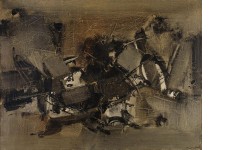TITΛΟΣ ΕΡΓΟΥΤΟ ΕΠΕΙΣΟΔΕΙΟ Νο 37
ΔΙΑΣΤΑΣΕΙΣ ΕΡΓΟΥΎψος : 97
Πλάτος : 130
ΥΛΙΚΟ ΚΑΤΑΣΚΕΥΗΣΕλαιογραφία (Λάδι σε καμβά)
ΥΠΟΓΡΑΦΗ ΚΑΛΛΙΤΕΧΝΗΚάτω Δεξιά
ΧΡΟΝΟΛΟΓΗΣΗ01-01-1961
ΕΛΕΓΧΟΣ ΓΝΗΣΙΟΤΗΤΑΣΔεν έχει ελεγχθεί

Footnotes
"I arrived at abstraction while seeking the quintessence of certain things"
J. Spyropoulos
Jannis Spyropoulos represents the most advanced and mature aspect of Greek abstraction. In his work, the melding of all the sources of abstract painting occurred with unprecedented developmental clarity and ascetic austerity. He was the first Greek painter who, while residing permanently in Greece, managed to attain an illustrious international career, highlighted by his participation in the 1960 Venice Biennale, where he was awarded the UNESCO prize. His works have been exhibited at and included in the most important European and American museums of modern art. 1
In 1961, Spyropoulos had one-man shows in New York, London and Milan, while during his solo exhibition at the Ostend Cultural Centre in Belgium he was awarded the citys Gold Medal. A marvellous painting from this years output, Episode no. 37 amply displays the art of a true master: wise compromise between gestural brushwork and sturdy compositional structure, utilization of a subdued yet highly expressive colour scheme, functional exploitation of texture, imposing light. These qualities transform the canvas into a field of exploding or clashing archetypal, cosmogonic opposites. Spyropoulos has always believed in the power of destruction, of conflict, but as part of a passage to a new articulation, a new genesis. This was the premise presented by his works from 1960 on, and this particular position of his in terms of the constant struggle between the limits of matter and the creative process is what gives his work its intense intellectual character. 2 Likewise art history professor Avi-Yonah makes the following comment: His works do not appear to symbolize something firmly constructed, but something which is growing all the time. However, this growth is not of a physical, but of a spiritual nature; it is rather a striving after light than a development of a physical presence The pictures act upon us as mysteries mysteries in the religious sense. The single linear shapes combine into magic signs. 3
This rich canvas also reflects Spyropoulos deep personal involvement in the traditions of Greece and especially in Byzantine art. It is an extremely beautiful painting, with a sense of colour that is rich and yet subdued, like a Byzantine icon or the Greek earth - the barren, craggy mountains, the olive trees and vines, the never-ending convolutions of the coastline4. Professor C. Christou notes: The golden-yellow colour that comes to dominate the work of Spyropoulos by 1960 and which in essence reflects nothing more than the presence of sunlight, or rather Greek light, is something he finds around and within himself, in the past from which he hails and the present where he belongs. It reveals the influence of the Byzantine icon painting he grew up with and his familiarity with the Greek light under which he lives, while at the same time his work expresses the intricate nature of modern artistic creation. 5 The final result is a daring declaration of artistic freedom, nonetheless obedient to an inner discipline; a splendid composition of energetic shapes that, ruled by an innate logic as well as unleashed emotion, tend to spread out beyond the confines of the canvas. The longer you look at a Spyropoulos painting, the more it expands before you, like the horizon. 6
1. See H. Kambouridis - G. Levounis, Modern Greek Art, The 20th Century
, Athens 1999, pp. 154-156.
2. E. Strousa, From Deconstruction to Genesis in Jannis Spyropoulos, Edition of the Workers Fellowship, Athens 1989, p. 43.
3. as quoted in Strousa, pp. 43-44.
4. See A. Weller, C. Spencer, J.P. Hodin, The Art of Jannis Spyropoulos adapted by B. Rothberg, The Charioteer review, no. 10, 1968, pp. 66-69.
5. C.Christou, Jannis Spyropoulos [in Greek], Athens 1962, p. 158.
6. O. Daniilopoulou, A Glance at the Art of Spyropoulos in Jannis Spyropoulos (1912-1990) , exh. cat., Macedonian Museum of Contemporary Art, Thessaloniki 1994, p. 49.